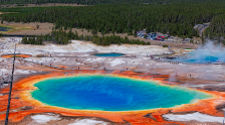
An essential activity in assessing the performance of Engineered Barrier Systems (EBSs) for disposal of radioactive waste is to demonstrate understanding of the long-term evolution of the construction materials and the neighbouring host rock, and to infer the consequences of any alteration to long-term performance.
Typical EBS designs incorporate engineering materials such as metals (typically steel or copper), clay buffer materials such as bentonite or sand/bentonite mixtures, cement and concrete for tunnel seals and fracture grouting and processed (e.g. crushed) quantities of host rock. Their interactions with one-another, and with the natural host rock barrier, will dictate the long-term stability and efficacy of the EBS. In particular, chemical material alteration can impact upon transport properties and result in perturbation of diffusion coefficients and permeability due to changes in porosity and/or pore structure.
In a recent feasibility study for Andra, Quintessa developed 1-D and 2-D models of EBS interactions for their HLW disposal concept in COx clay host rock using the general purpose coupled modelling code, QPAC, and its reactive transport module. The models included iron - bentonite, bentonite - cement, bentonite - COx and cement - COx interfaces in a single 2-D simulation and included full coupling of transport and kinetic reaction processes in the clay/rock features, and treatment of redox evolution around iron surfaces undergoing corrosion. The models also included a novel treatment of transport and reaction in and around regions in which porosity had become clogged due to cement carbonation, through the addition of a custom porosity/reaction model.